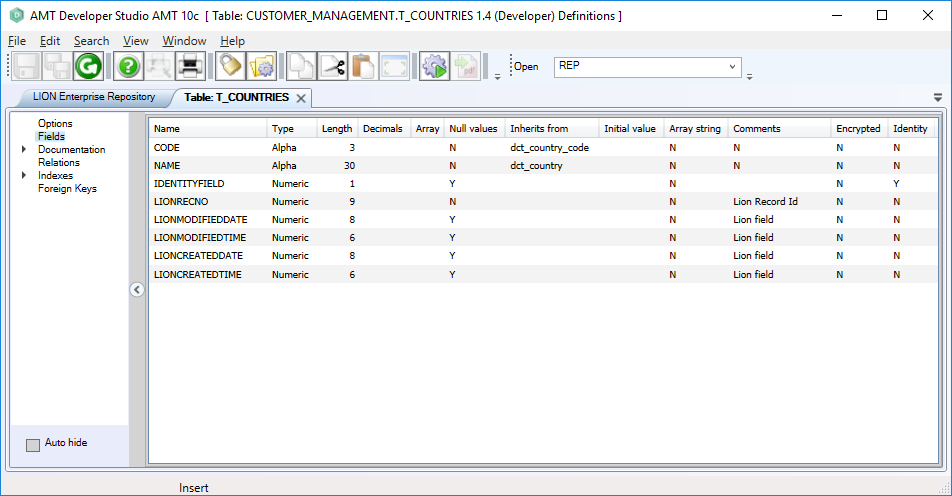Fields
The fields on a table can be edited as follows:
- Select the "Fields" node in the left-hand pane:

- Ensure that the table is locked by selecting the lock button in the toolbar.
- To insert a field: right-click in the right-hand pane and select "Insert".
- To delete a field: right-click on the field name and choose "Delete".
- Field properties are set via the object inspector. You can also set it via the bulk mode screen by right-clicking in the right-hand pane and choosing the option "Bulk Mode". The bulk mode screen lets you view and edit the fields in a free-format text window. See Bulk Mode for more information.
The following properties are set on the Fields screen:
|
Properties |
Description |
Available Values |
||||||||||||
|
Name |
Name of the field. If set to the name of a Dictionary item, the field will inherit the properties of that Dictionary item. |
<Text> | ||||||||||||
|
Type |
Field type.
To insert fields inside a structure, create a Structure field and then select the END_STRUCTURE
field. Inserting fields will then add the fields inside the structure. |
<Alpha | Boolean | Financial | Int32 | Integer | Numeric | Signed | String | Structure | DbsDate | DbsDateTime | DbsTime > | ||||||||||||
|
Length |
The maximum number of characters for the field, including any decimal positions. Not applicable for String, Integer or Boolean. With Database (Date)Time types this indicates the number of fractional seconds. |
<Integer> | ||||||||||||
|
Decimals |
Number of decimals for the field, which is included in the Length. | <Integer> | ||||||||||||
|
Array |
Array dimensions. Up to 6 dimensions can be specified, separated by commas. | <[Integer], [Integer], ..]> | ||||||||||||
|
Array stringfield
|
This would only need to be set to True if an array of type 'String' were
to exceed its top boundary of 8096 bytes. |
<True>/<False> | ||||||||||||
|
Comment
|
Description of the field. | <Text> | ||||||||||||
| DbFieldType | The database field type, which is used in the application database. Possible types depend on both the chosen AMT field type, length, decimals, dictionary and the database type specified in the generation set. See the Database field types page for information on the usage and behaviour of this setting. Please note that the developer is responsible for ensuring that the chosen AMT field fits in the chosen DbFieldType when selecting a DbFieldType different from the default type. |
<Database specific field type> See 'Database field types' for all possible options. |
||||||||||||
|
Inherits from / |
The name of the Dictionary item from which the parameter properties are inherited. | <Dictionary item name> | ||||||||||||
|
Encrypted
|
If set to True, the field values are stored encrypted in the runtime database. If this option is changed, the database reorganization process encrypts/decrypts the field values. Encryption has the following consequences:
warning Warning: Fields used as Keys in Indexes should never be encrypted, because the database server will apply the index on the encrypted value leading to unexpected results. warning Encryption for remote databases is not supported. |
<True>/<False> | ||||||||||||
| Identity |
If identity is set, the field will automatically be filled with the next unique value when a new record is inserted. The identity property can only be set to numeric field types. It is not possible to update the identity field. It is not possible to have multiple identity-fields in one table. If a field is set as identity field, the build in AMT identity field LIONRECNO will be removed from the table. |
<True>/<False> | ||||||||||||
|
Initial value |
Default value that is assigned to the field.
|
<text>/<Empty String>/<Null Value> | ||||||||||||
|
NULL values |
If set to True, it is possible to store NULL values in the field. If set to False, it is not possible to store NULL values in the field. Fields that belong to a table index are always set to False. During the reorganization of the runtime database, AMT makes sure that the database settings in this database are always according to the NULL Values property. Please note that if a new field is added to a table containing data(rows) that does not allow NULL values, an initial value should also be set (see above), otherwise the reorganization process will fail. Alternatively it is possible to set the new field to allow NULL values initially and after a reorganization, to modify the field to disallow NULL values to be stored. If set to True and the initial value field is left empty (or was cleared), the initial value will be a NULL when using a free join query. When using Cursor queries and Table queries the initial value will be an empty string for alpha numeric types and 0 (zero) for numeric types. |
<True>/<False> |
